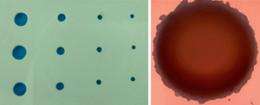Rethinking the process used to machine industrially important ceramics could reduce damaging cracks and chips

Ceramics are hard, chemically inert and can withstand high temperatures. These attributes make them ideal structural components in engines, high-performance disk brakes and medical implants. However, as ceramics are also brittle, using conventional tools—such as drills—to machine them is difficult. Instead, manufacturers rely on ultrasonic machining, in which a 'hammer' rapidly vibrates up and down. This process pushes slurry, which contains fine and abrasive grit, into the material and causes chipping.
Research by G.C. Lim and co-workers at the A*STAR Institute of Manufacturing Technology, Singapore, has now improved understanding of how this abrading process creates cracks in a ceramic, making it less durable for applications. The team's findings could inspire new approaches to machining ceramics, a key element in Singapore's rapidly growing manufacturing sector.
Ultrasonic machining is known to leave cracks at the entrance and exit of a drilled hole, and a rough surface within the hole (see image). Often, these defects are visible only under a microscope; nonetheless, they make the hole and surrounding material more susceptible to wear and tear. "Imperfections act as initiating locations, where cracks and fractures occur and propagate more easily than other places, resulting in early failure of the component," says Lim.
The researchers studied crack formation by drilling holes of between 0.7 and 3.0 millimeters in diameter into plates made of 3 industrially important ceramics: silicon carbide, zirconia and alumina. They recorded images of the cracks and chips along the inner sides of the holes with a microscope and then used diagrams to model the way force is transferred from the hammering tool to the grit, and from the grit into the ceramic.
Lim and his colleagues found that as the grit removes material—by making tiny pits or rubbing against the walls—it creates cracks, which can be up to four times longer than the grit particles and extend out radially from the hole. The team concluded that these cracks are inherent to the way ultrasonic machining works, which means the number of cracks can be reduced by using smaller grit particles but never entirely eliminated.
Lim says they are now in a better position to optimize the drilling process. Since the smallest grit particles yield the smoothest holes but make drilling take longer, Lim recommends a two-step process: quickly drill a slightly smaller hole than needed with a large grit size, and then use a smaller grit size to make the final hole with a smooth finish.
More information: Nath, C., Lim, G. C., & Zheng, H. Y. Influence of the material removal mechanisms on hole integrity in ultrasonic machining of structural ceramics. Ultrasonics 52, 605–613 (2012). www.sciencedirect.com/science/ … ii/S0041624X11002770



















